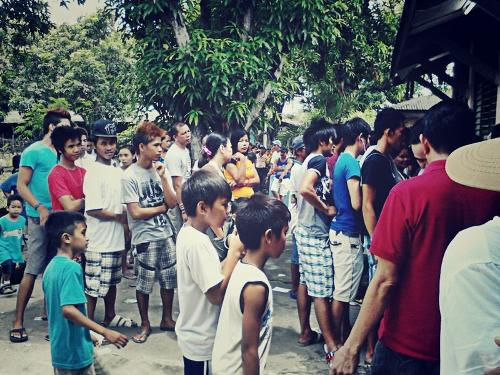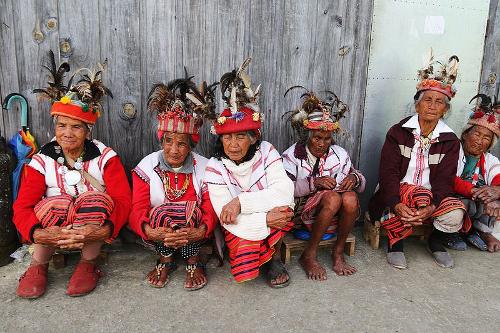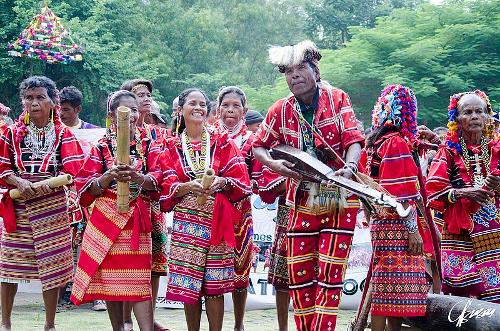PHILIPPINES
Population

Population
Cities in PHILIPPINES
| Manila |
Population
The composition and dispersion
 Philippines PopulationPhoto: Pancit Canton Media in the public domain
Philippines PopulationPhoto: Pancit Canton Media in the public domain
GENERAL
The Filipinos, who make up 80% of the total population, are mainly descended from Indo-Malays, Chinese and Spaniards. They have entered the archipelago in a few population movements. The most important Filipino groups are the Tagalog (26%) and the Bisaya (14%).
MINORITIES
The archipelago of the Philippines is made up of the negritos, closely related to the Semang of Malaysia and perhaps the dwarf population of the Andaman Islands. In total, the number of purebred negritos is estimated at about 15,000, including several thousand Aëta, a dwarf people who mainly live on the island of Luzon. Other negrito groups are the Atta, Dumagat, Agta and Ati. In the past they were real collectors and hunters, nowadays most live in permanent settlements.
The Muslim Moros make up 5% of the Philippine population and live in Mindanao, the Sulu Islands and Palawan. The largest Muslim group in the Philippines are the Maranao, who live in Mindanao. They live on livestock, agriculture and trade. The residential area of the Maguindanao is located in the valley of the Rio Grande.
The main population group of the Sulu archipelago are the Tausug, who live from agriculture and rice cultivation. They were the first Muslims of the Philippines and mainly live on the island of Jolo. The Samal also live in the Sulu archipelago and most of them live on stilt houses along the coast.
The coastal inhabitants of the island of Basilan are the Yakan, who live from fishing.
A separate group from the Sulu Archipelago are the Bajao Laut or "people of the sea". These sea gypsies generally do not live in dwellings on the mainland, but on houseboats. The initially animistic Bajao hunt in long wooden boats ("lipa") on the Sulfur and the Celebes Sea. More and more Bajao live on the mainland and often convert to Islam.
The Chinese make up 1% of the population, but generally have the Philippine nationality.
 Igorot PhilippinesPhoto: Yves Picq CC 4.0 International no cjhanges made
Igorot PhilippinesPhoto: Yves Picq CC 4.0 International no cjhanges made
A number of tribes live in the Central Highlands, collectively known as "Igorot". They are descendants of the Proto-Malays, who long ago immigrated to the Philippines from Indonesia and Southeast Asia. Later they were supplanted by the late Malays. Not so long ago, headhunting was commonplace and blood feuds are still occasionally used. Some of the Igorot tribes are Ifugao (230,000), Bontoc (185,000), Kalinga, Ibaloi, Kankanai, Tinggian and Apayao. These hill tribes have become famous for the construction of wet rice terraces that are between 2000 and 3000 years old.
The mountainous interior of Mindoro is home to a number of proto-Malay tribes, collectively known as the Mangyan. Some of the tribes are the Alangan and the Hanunóo, who live from arable farming, fishing and hunting.
The primeval population of Palawan includes the Batak. This tribe, generally part of the negritos, grows crops such as cassava, sweet potatoes and maize, collects honey and wild fruits, and hunts animals.
Other tribes in Palawan are the Tagbanua, the Calamianon, the Pala'wan and the Jama-Mapun, an Islamic tribe.
 Bagobo PhilippinesPhoto: Constantine Augustin CC 2.0 Generic no changes made
Bagobo PhilippinesPhoto: Constantine Augustin CC 2.0 Generic no changes made
Mindanao's originally animistic tribes are increasingly influenced by their Christian and Muslim neighbors. This applies to the Bagobo, the Subanon, the Manobo and the Tiruray. In addition, the T'boli or Tagabili, the Mandaya and the Mansaka live on Mindanao.
In 1971, an unknown small tribe of 26 individuals, the Tasaday, was discovered. They still lived in very primitive circumstances and had never had contact with the outside world. Fifteen years later, it was announced that the whole affair had been staged. At present, scholars are not in agreement as to what the real truth is.
DISPERSION
More than half of the Filipino population lives on the island of Luzon, with a concentration in the capital Manila. Manila, together with Quézon City, Pasay and Caloocan, belongs to the National Capital Region (also known as Greater Manila or Metropolitan Manila) with almost 15 million inhabitants. Other large cities are Davoa (1,950,000), Cebu (1,025,000) and Zamboanga (931,000). (2024)
The differences in population density are large; Only about 40 inhabitants per km2 live on the island of Palawan, on the island of Cebu an average of 500 inhabitants per km2. Government encourages migration from overcrowded Luzon to Mindanao and other sparsely populated islands. Approx. 50% of the population lives in urban areas.
Demographic data
The Philippines had an estimated 118 million residents in 2024. The population density is approximately 390 inhabitants per km2.
The Philippines has a relatively young population; over 30.2% of the population is younger than 15 years old. (2024)
Population growth averages 1.56% per year. (2024)
Average life expectancy at birth is 70.8 years, men 67.3 years and women 74.5 years (2024)
The Philippines has a birth rate of 22.1 per 1,000 residents and a death rate of 6.2 per 1,000 residents.
Sources
Filippijnen
Het Spectrum
Philippines
Lonely Planet
Poppe, D. / Reishandboek Filippijnen
Elmar
Rodell, P.A. / Culture and customs of the Philippines
Greenwood Press
Wee, J. / Philippines
Chelsea House
CIA - World Factbook
BBC - Country Profiles
Copyright: Team The World of Info